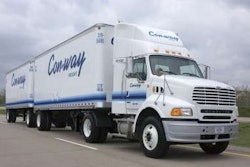Cell phones a growing problem on America’s highways
The first time I drove on the Autobahn in Germany, my immediate reaction (beyond realizing this was no place to be daydreaming) was: This would never work in the States. The average American just isn’t trained to handle driving at these speeds.
“Trained” is the operative word here: The Germans have a rather complex and graduated approach to driver instruction. They let their kids behind the wheel in stages, and take great pains to ensure that they’re ready to handle close traffic at speeds up to 150 mph. A funny type of collective behavior seems to reinforce this training: Germans generally practice good driving techniques such as adhering to strict lane discipline and seem to realize that the system works best if everyone buys into – and follows – the rules of the road.
Over here, not so much. Look around an American highway, and there’s no telling what you might see going on behind the wheel: Burgers being eaten, makeup being put on, books or newspapers being read, stereos and MP3 players being adjusted, and increasingly drivers talking or – worse – texting on their cell phones.
I thought about the mounting distractions facing drivers today as I read on CNN’s Tech webpage an article declaring that talking on a cell phone behind the wheel was as bad as driving drunk. According to the study conducted by the University of Utah, engaging in a phone conversation on a mobile device – either a handheld or hands-free device – while driving distracts the brain, delays reaction times and makes drivers more likely to swerve between lanes, slow down and miss important signs.
Of course, truck drivers have been talking on CB radios for more than 30 years without drawing any attention to themselves as distracting or unsafe. Why is this? Some experts contend that drivers engaged in a CB radio conversation typically are discussing traffic and highway conditions within a relatively short four-mile range with drivers on the same stretch of road. The result is a temporary community focused on localized driving conditions that enhances safety, or at the very least heightens the drivers’ situational awareness. Cell phone conversations, on the other hand, often are carried out with persons who may be hundreds of miles away and deal with topics light years removed from the actual mechanics of driving a car or truck safely.
Currently, six states and the District of Columbia have laws banning the use of cell phones while driving, although no state bans the use of hands-free devices. Almost all states have looked at legislation that would ban cell phone conversations while driving, though.
For trucking companies, there doesn’t seem to be a lot of wiggle room on this one. As useful as cell phones can be, in today’s litigious society, an accident caused by a driver chatting on his phone is giving an opposing lawyer a slam dunk. Some trucking companies are banning cell phone use while driving, but enforcement is problematic.
As usual, technology may hold the answer. For example, Aegis Mobility, a Vancouver, British Columbia-based company, has created a device called DriveAssist designed to enable cell phones to detect automatically when a mobile user is driving. Users can subscribe to DriveAssist’s service, which manages incoming and outgoing calls, text messages and e-mails electronically. Callers get a message that the recipient is driving but can leave an emergency message alerting the driver to pull over and return the call. Optionally, passengers can choose to override DriveAssist and accept incoming calls and place outbound calls without interruption. DriveAssist is set to appear in the United States this fall.
That’s just one example of how technology can help drivers keep their minds on driving and their hands on the steering wheel. Until then, education about the dangers of cell phone conversations on the road may be your best defense against distracted drivers.













